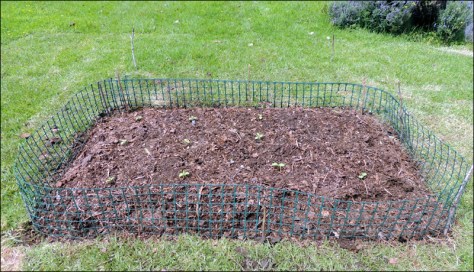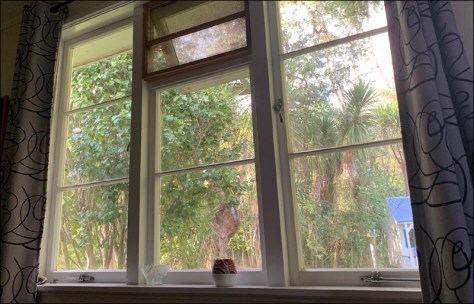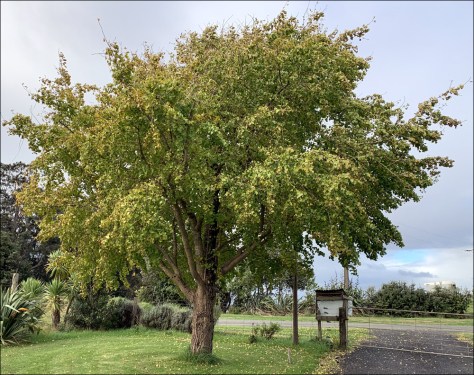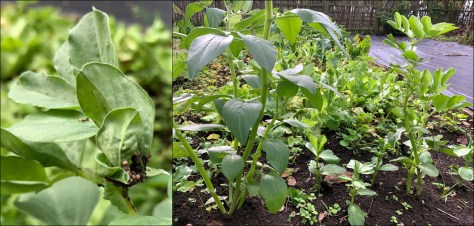Warmer Weather

Time has scooted by. I last wrote in June and since then, South Head has experienced days, weeks and months of disappointing weather. Strong winds that have swept branches off trees. Downpours so heavy that gutters have overflowed, whole sections of the garden borders have been submerged, and fragile seedlings have been battered. We’ve had numerous power cuts and the gravel road outside our property has been chewed up by logging and stock trucks, or on the rainless days (I hesitate to use the word ‘sunny’), clouds of dust have drifted onto the solar panels, propelled by any car that takes the slope down past our place a little too fast.
While I can’t do anything about the vehicles going past, November is in the air, and perhaps the weather will finally settle.
The garden, overall
The easterly gales of the past few days have done their dash, allowing the sun to finally slip out from under her korowai of clouds. After lunch today, the temperature climbed from 17 to 24 in the space of 30 minutes. I was intending to study, but instead of once again putting blogging on the back burner, I chose instead to defer my study . 🙂

Of course the gardens don’t care about the miserable weather, they’ve just carried on doing their stuff. In fact everything is horrifically lush, and it’s nearly impossible to keep up with the weeds and the lawn mowing. Nothing holds the natural world back; last time I posted we were still collecting feijoa and now they’re back in bloom for the next season of fruit.

It’s the same with the avocados. We’re still harvesting the crop from last year’s flowering, while alongside them on the tree, the new baby fruit are starting to set. I guess this at least shows we had some windless days. It’s difficult for bees to pollinate flowers when its blowing a gale.

Fruiting cherries don’t do so well this far north, they like a hard frost, but our two struggling trees still manage to produce some blossom. The same can’t be said for limes. The two lime trees are smothered with flowers, despite being afflicted badly by citrus borer. And there’s nothing nicer than seeing the first plump buds on the pear tree.
This year I was determined to raise all our flowers and vegetables from seed. I’ve had some disappointments – baby plants being dug up by blackbirds, or chewed by beetles, slugs and snails. Some have failed to germinate, but I haven’t give up. Some I clearly put out too early, even though we don’t experience frosts this far north. My earliest gherkins, zucchinis and squashes just sat in the ground looking sorry for themselves before finally curling up and dying. But, I’ve had many more successes than disappointments.
Things we can eat
Broad beans

The broad bean plants were only a few centimetres tall in June, but now we’re consuming their crop. I like to nuke the beans into a paste with a little butter and miso. The plants themselves have grown far taller than we expected. The seed packet suggested staking them at one metre, but they’ve kept on growing, and now reach to over two metres. Every time a wind has howled in from a new direction, we’ve had to scurry outside to re-tie them.
Tomatoes

Our tomatoes are many. I think I counted 25 out there. The three varieties I chose to sow this year are Black Krim (a delicious heirloom variety), Bloody Butcher (a good all-rounder) and the cherry tomato, Indigo Blue Berries. The first fruits are forming and I can’t wait to have fresh outdoor tomatoes again. Proper tomatoes. Through most of winter I’ve resisted buying store tomatoes as they just aren’t the same. Tomatoes are just about my favourite plant to grow. They’re so easy, and so versatile, and after having lived in Dunedin for 25 years, I still haven’t quite gotten used to growing them outdoors.
Garlic and Egyptian walking onions

It was April when we put down the groundcover on a complete length of the vegetable garden. This activity certainly paid off and the patch is now home for garlic, onions, lettuces and tomatoes. We’ve mulched them with compost a couple of times already, but it’s already difficult to see where it was. Compost mulches will be critical as the days grow warmer. They protect and feed the plants, and keep the moisture down in the soil when the summer sun is doing its best to evaporate it off.
Grapes

This grapevine has been slow to get established, unlike the white variety that grows rampantly on the northern side of the barn. The grape is Albany Surprise and in my opinion is far superior to the white grape, due to the sweet and spicy flavour of its juicy bunches. The vine is looking really good this year, with numerous clusters of fruit.
Gardens new and gardens relocated

Ben has dug me a brand new garden – a bed for melons. We’ve tried to grow these before and we just put the plants in the back paddock and left them, assuming they’d survive. Well, they didn’t. Or actually, they did, but I think all they produced was a couple of tiny, tiny fruit. This year we have a dedicated bed filled with compost and in sunlight for most of the day. I’ve raised seedlings of rock and watermelon, and am hoping for the best!
The bed is in the middle of the lawn close to the house so we can easily keep an eye on it, but already the sparrows have been in and have tossed the compost around. Fingers crossed the plants will get their roots going and dig in before they, too, are evicted. Only the rock melons are planted for now; I need twice as much space to fit the watermelons in as well.
Strawberries

Another task we achieved since June was to dig up our congested bed of strawberries. We selected a few strong plants, and replanted them beneath the lemon verbena. We’re hoping that they’ll do better there, especially with the netting cover. Usually our strawberries get picked to pieces by the blackbirds who nest in the trees near the vegetable garden.
Beehive update

One of our three hives failed over winter. We lost the queen, and think that she most likely died of natural causes; she was never a strong queen. We weren’t completely surprised, as even before we confirmed the loss, the hive had very little brood. So we cleaned up the hive and surrounding area and last weekend added the honey boxes to the brood boxes.
The two remaining hives are buzzing! And on days like this the bees are out and about collecting pollen and nectar. There are so many plants in flower this time of year that there’s nothing to hold them back. Standing beneath one of the olive trees, earlier today, all I could hear was the satisfying hum of the bees.
Plants of the flowering kind

My new project has been to clean up and tidy the strip of garden alongside the pathway in front of our kitchen window. It has always been a problem due to a nasty weed (a bulb) that I haven’t been able to eliminate. I’ve been trying for years.
Ben became so fed up at the hours I’ve spent in this small area, that he suggested digging out and removing all of the soil, and replacing it with compost and new soil. It was the best thing we could have done.
I love this new garden and even though it’s still early days and there’s not much flowering there yet, I can see it from the kitchen window and it always cheers me up. An amusing extra is that the compost was filled with seeds from the vegetable garden. Lettuces, dill, coriander, even a couple of tomatoes have sprouted. I doubt that the dill can stay there for long, but I might leave a couple.
I’ve planted the majority of my basil seedlings there, as well as pinks, dahlia, zinnias, poppies, bellis, and viola, so it will be a cottage-cum-kitchen garden. I’m looking forward to posting some photos once the seedlings begin to mature.

Despite the shambles in my various flower beds, it’s still lovely to see the spring flowers. Every flower gives me a good feeling.

Whether it’s the poppies I’ve raised from seed, or the blossom on the fruit trees. Each flower is a promise of something… a pure splash of colour, a beautiful aroma, or a juicy piece of fruit.
Native Garden

I thought I should mention our small native garden. This is situated in an area that was just weeds and junk when we first bought the property. It’s got to the stage now that trees self-sow, and our original specimens are reaching up to the sky.
Not bad for less than ten years of growth!
Garden reality and reminiscing

The garden is still untidy and there’s always more to be done. Sometimes it feels that for every step forward, there are two steps backwards. Once the weather begins to warm, which it’s doing now, everything just takes off.
This time last year I was staying at Mt Maunganui with Dad, and regularly visiting Mum in the rest home. While I was there, I was yearning for my garden, so I can’t complain about the work now.
My love of gardening and of having a garden began when I was a small child. In the early years Dad kept a vegetable garden, and we had fruit trees. From Mum I picked up a love of the beauty of flowers and trees. I regret that Dad never made it back to my garden. I’d always imagined a time when he would see out his last few years here, pottering around doing the outside things he liked to do.
On a garden rake
Dad tows me between the rows.
Moist earth, a bird cries.
(26/10/2021)


































